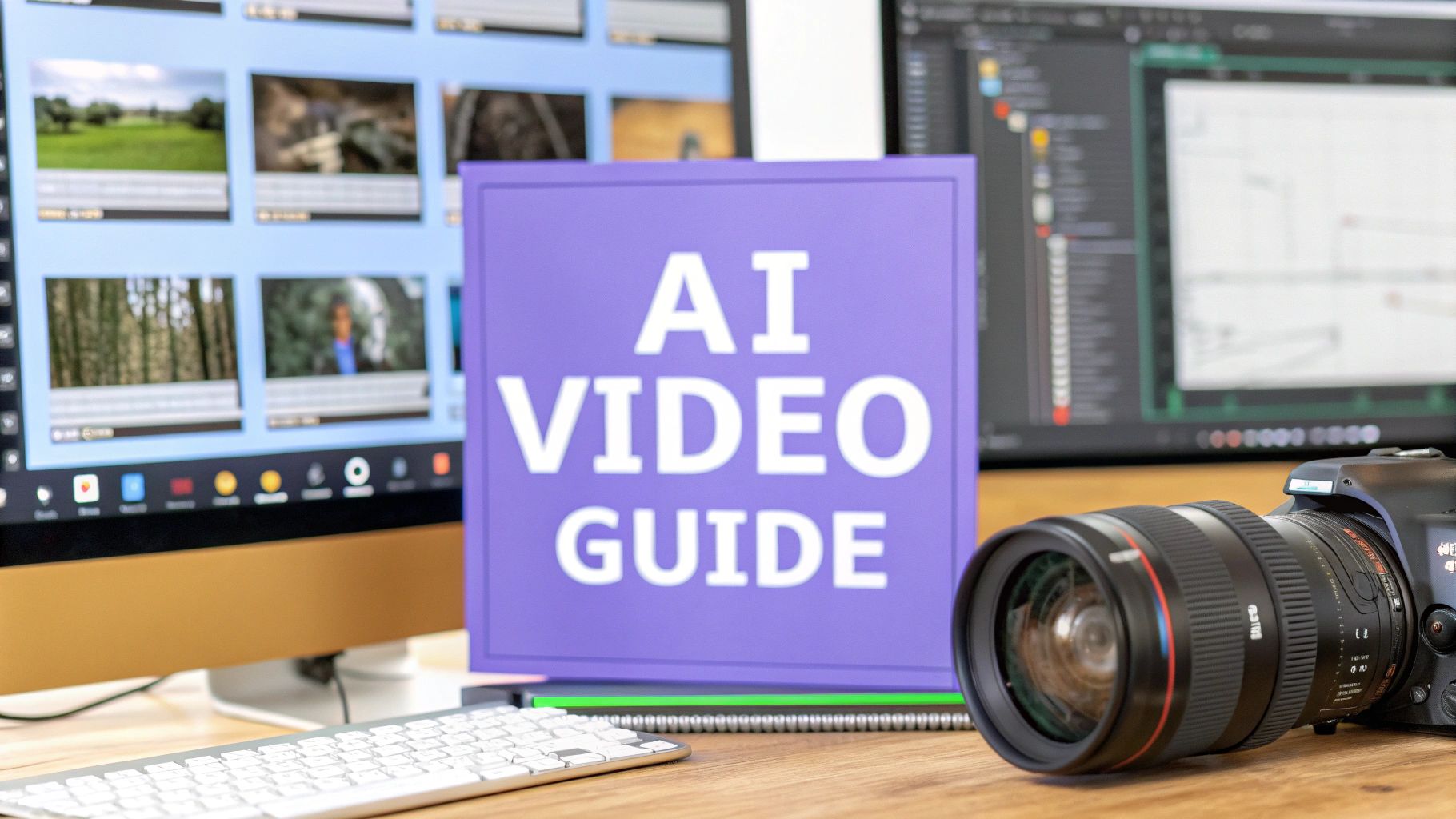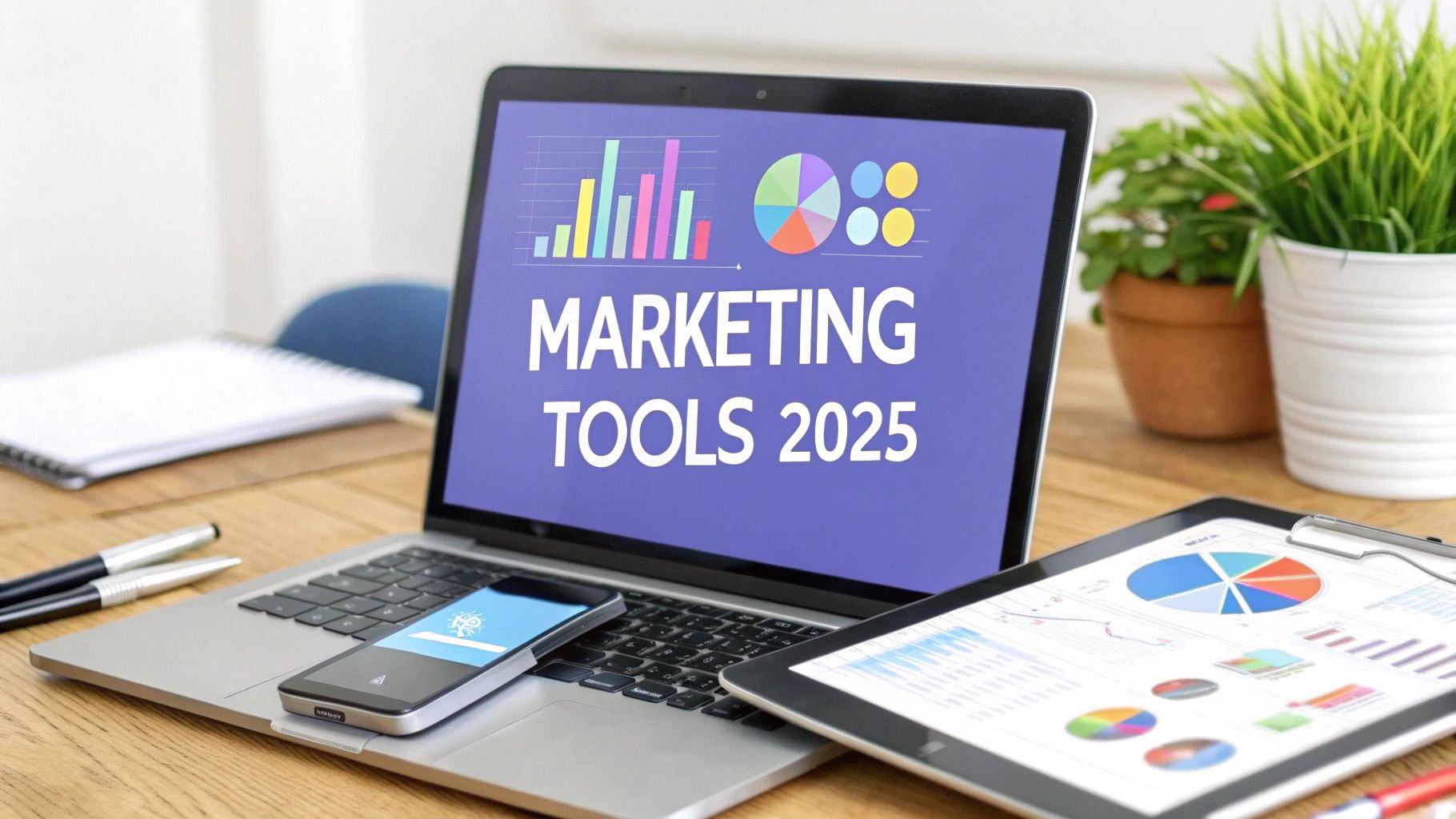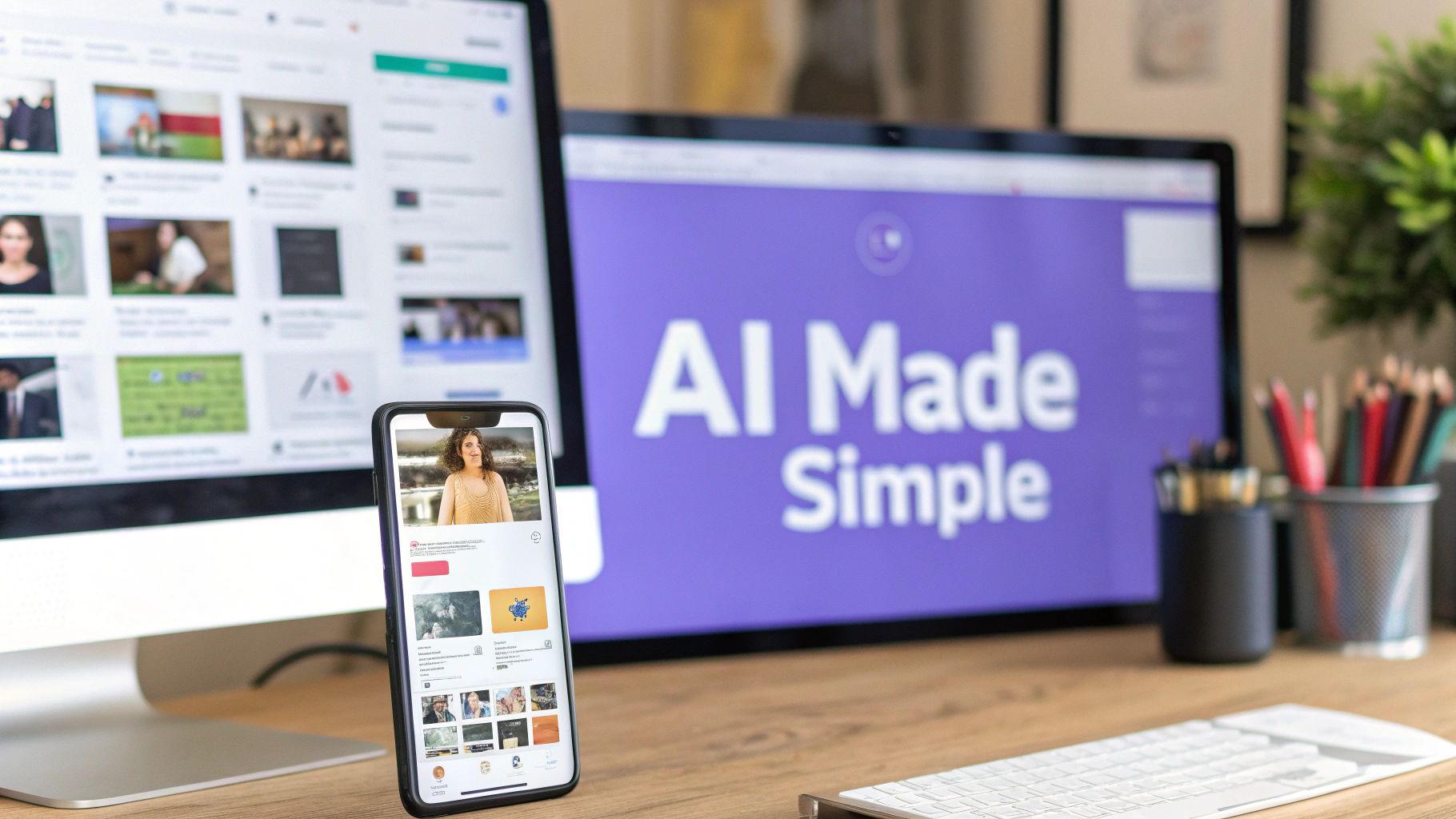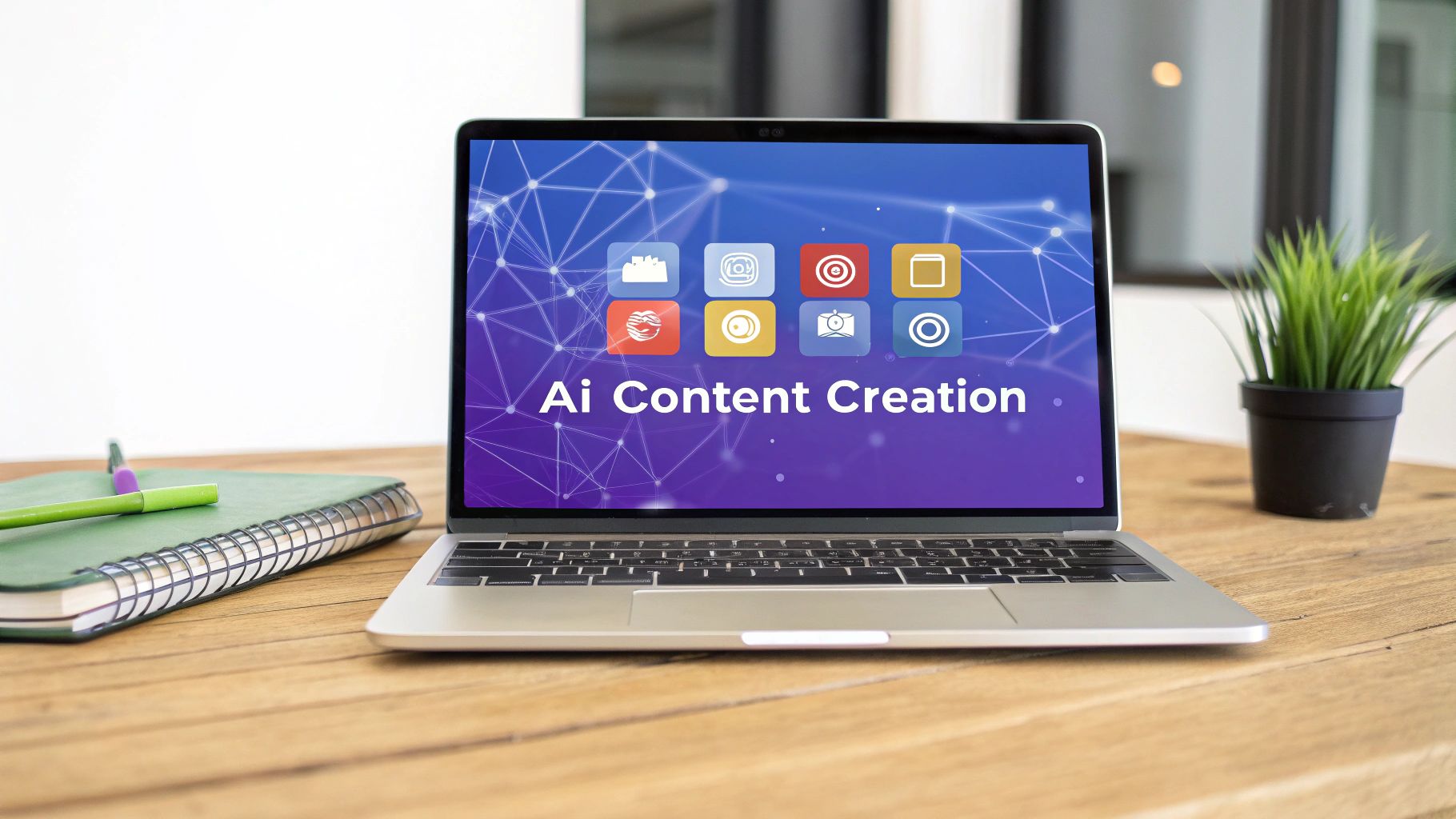Making a video with AI is a fascinating blend of human creativity and machine intelligence. The basic flow involves writing a script, using text prompts to generate visuals, creating a voiceover, and then piecing it all together in an editor. You bring the ideas, and AI models generate unique visual content from your descriptions.
The Reality of AI Video Creation Today
Welcome to the new frontier of video production. If you're used to the old, slow, and expensive way of doing things, get ready for a major change. Making videos with AI is a completely different ballgame—it's fast, flexible, and driven by ideas, not just resources.
AI has graduated from being a simple editing assistant to a full-blown creative partner. These tools can help write scripts, dream up entire scenes from a few words, and even generate realistic voiceovers. This shift is empowering everyone from solo creators to big marketing teams to produce content at a speed and scale that was once impossible.
The numbers back this up. The global AI video market was valued at USD 3.86 billion in 2024 and is expected to rocket to USD 42.29 billion by 2033. That’s not just growth; it’s an explosion, showing just how quickly this technology is being adopted.
A New Creative Workflow
Think of this new workflow as a way to enhance your creativity, not replace it. Your main job shifts from managing physical shoots to refining your creative vision into the perfect text prompt.
- From Concept to Screen: Your most important skill becomes translating a clear vision into words an AI can understand and execute.
- Rapid Iteration: You can experiment with dozens of visual styles and concepts in the same amount of time it would take to set up a single traditional camera shot.
- Accessibility: Suddenly, high-quality video production isn't just for those with big budgets and fancy equipment. It’s now within reach for small businesses and individual creators.
If you want to dig deeper into this, our guide on https://sprello.ai/blog/automated-video-creation has some great tips on making the process even smoother.
Just look at what's possible with high-end AI video generators. This shot was created by OpenAI’s model from a simple text prompt.
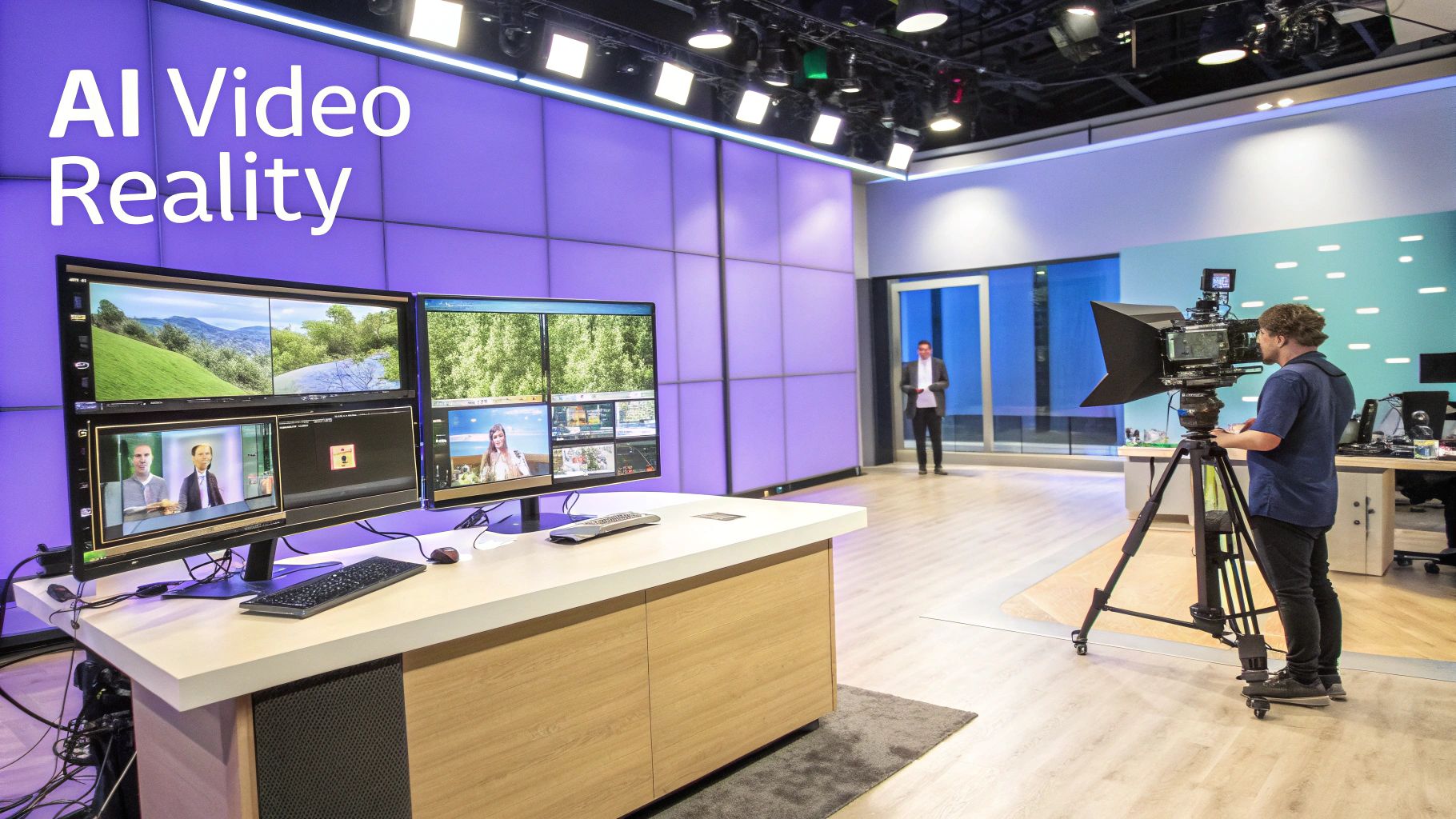
It’s a perfect example of how an AI can interpret language to generate photorealistic scenes with incredibly complex lighting and detail. To really get a feel for where this is all heading, it's worth checking out groundbreaking models like Sora.
Planning Your AI-Powered Video Project
Before you even think about generating a single frame, you need a solid plan. I've seen it time and time again: people get excited, jump straight into an AI tool, and end up with a jumbled mess. A little bit of prep work is the secret sauce that makes the whole process go smoothly.
First things first, what's the point of the video? What do you want it to do? A punchy social media ad designed to get clicks is a completely different beast than an in-depth explainer video for your website. Your goal shapes everything that follows—the tone, the style, and how complex it needs to be.
Next up, who are you talking to? You wouldn't use the same language and visuals for a group of software developers as you would for busy parents. Knowing your audience helps you nail the pacing and style so your message actually connects with them.
Structuring Your Narrative
Okay, with your goal and audience locked in, it's time to brainstorm. This is where you can really lean into what AI video generators do best. Think surreal landscapes, mind-bending abstract animations, and lightning-fast cuts.
On the flip side, know the limitations. Getting an AI to keep a character looking exactly the same across a dozen different complex scenes is still a major challenge. So, build your story with that in mind.
A simple shot list or a rough storyboard is your best friend here. It doesn't have to be a masterpiece. Just a quick outline will do the trick.
- Scene 1: Wide shot of a futuristic city skyline, dusk, glowing neon signs.
- Scene 2: Tight close-up on a character's face, reflected in a holographic display.
- Scene 3: Fast montage—flashing data streams, glowing circuit board patterns, quick zooms.
Think of this as your blueprint. It keeps your story on track and stops you from getting distracted by all the cool things the AI can do, focusing instead on what it should do for your video.
Writing for an AI Co-Creator
Your script and your prompts are the direct instructions you're giving the AI. If you're vague, you'll get vague, generic results. You have to be descriptive and specific. I always tell people to imagine they're directing an incredibly literal-minded but brilliant artist.
Pro Tip: A great formula for prompts is [Subject] + [Action] + [Environment] + [Style]. Instead of just "a car driving," try something like: "a vintage red convertible speeding down a winding coastal highway at sunset, golden hour lighting, cinematic 4K." See the difference? That's the level of detail that gets you amazing results.
This whole planning stage ensures every clip has a purpose. When you start managing bigger projects, keeping everything organized is key. For a really streamlined workflow, you might even look into AI-driven scheduling solutions for post-production. A well-managed process, from the first idea to the final export, is what separates amateur attempts from consistently high-quality AI videos.
Choosing the Right AI Video Tools
With so many AI video platforms out there, it’s easy to feel a bit lost. The trick is to find the right tool for the job. Not every AI video generator does the same thing—some are specialists, and figuring out what you actually need is the first real step.
This space is absolutely exploding right now. Think about it: the market for AI video generators was valued at around USD 534.4 million in 2024 and is expected to rocket to nearly USD 2.56 billion by 2032. That’s not just a trend; it’s a fundamental shift in how we create video content. For a deeper look at the numbers, this report on AI video generator statistics breaks it all down.
To get started, let's look at the different kinds of tools and what they're good for.
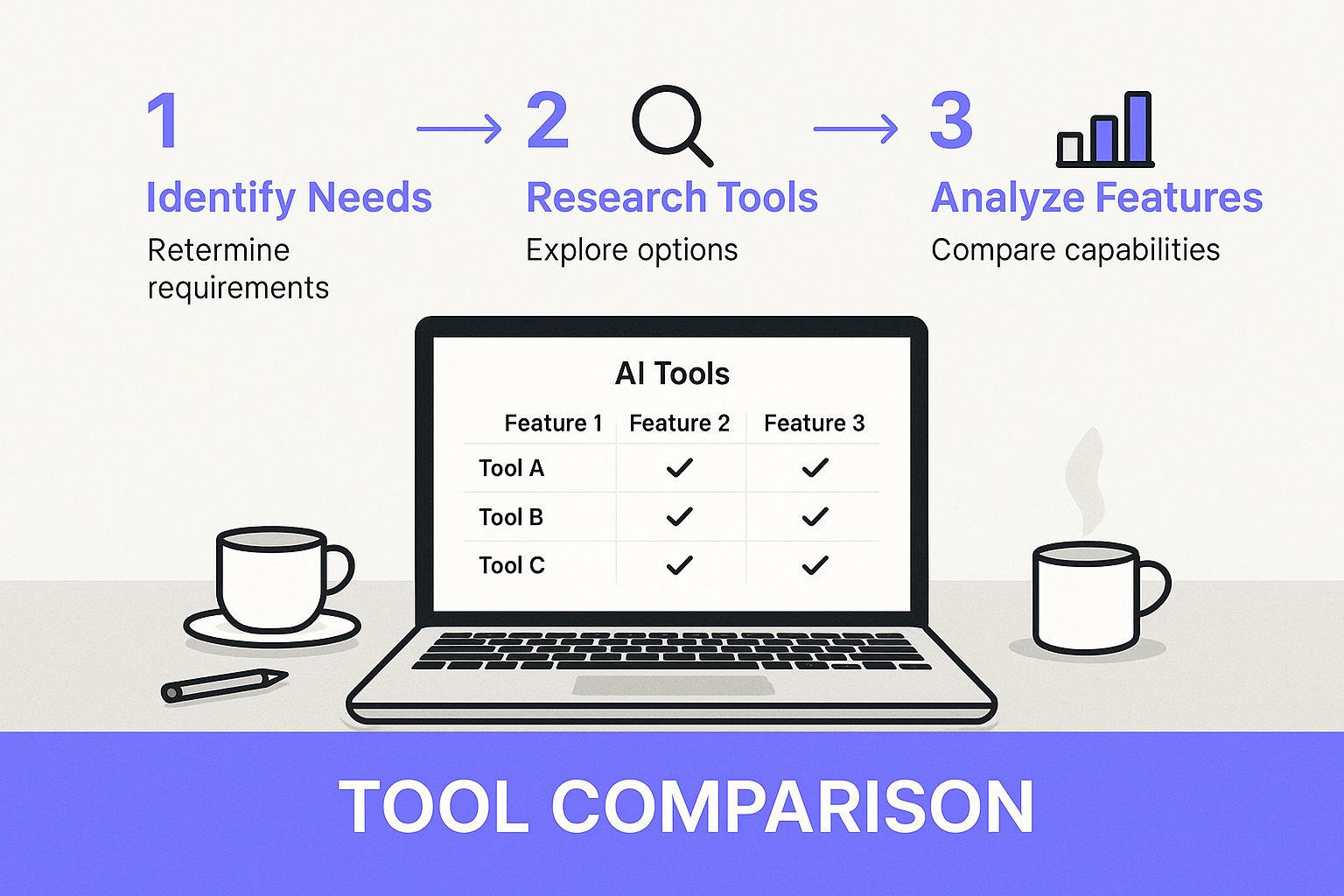
As you can see, what you’re trying to achieve—whether it's conjuring a scene from thin air or just polishing up what you already have—determines which type of AI tool you’ll want to reach for.
Text-to-Video Generators
These are the pure creators. You give them a text prompt, and they generate entirely new video clips. This is fantastic if you're a marketer needing a quick social media ad or a storyteller who wants to visualize an idea without touching a camera.
Think of them as your personal stock footage library, but one where you direct every shot. For example, typing in "a golden retriever catching a frisbee in a sunny park, slow motion" can give you a brand-new, high-quality clip in moments. I’ve found that the real magic is in the details—the more descriptive your prompt, the closer you’ll get to what's in your head.
AI Avatar and Voice Generators
Sometimes, you don't need a whole scene. You just need a face and a voice to deliver your message. AI avatar platforms let you create a digital presenter who can read your script in just about any language or tone you can imagine.
This is a huge time-saver for anyone creating training materials, corporate updates, or educational videos. Forget hiring actors or booking a studio. You can get a polished, professional-looking presentation done in minutes. The quality has gotten so good lately, with avatars now showing much more realistic expressions and movements.
My Personal Tip: The best approach is to build a small toolkit. I often use a text-to-video tool for B-roll footage, an avatar platform for the main narration, and then an AI-assisted editor to stitch it all together. This gives you a complete production workflow from start to finish.
AI-Assisted Video Editors
Finally, we have the tools that help you assemble and polish the final cut. These editors aren't about creating new content from scratch; they’re about making the editing process smarter and a whole lot faster.
Most of them come packed with useful features, such as:
- Automatic Scene Detection: The software analyzes your footage and intelligently breaks it down into individual clips for you.
- AI-Powered Color Correction: With a single click, you can get consistent, balanced color across all your different shots.
- Smart Trimming: This is a lifesaver. It automatically finds and removes awkward silences or long pauses from your clips.
These editors are perfect for anyone looking to cut down on the tedious parts of post-production.
To help you get a better sense of the specific platforms out there, here's a quick comparison of some popular options.
Comparing Popular AI Video Generator Platforms
Choosing the right platform really depends on your specific needs—whether that's ease of use, creative control, or a specific feature like realistic avatars. This table gives you a quick-glance comparison to help you narrow down the options.
| Tool Name | Best For | Key Feature | Pricing Model |
|---|---|---|---|
| Synthesia | Corporate training & instructional videos | Realistic AI avatars & multi-language support | Subscription |
| Runway | Creative professionals & filmmakers | Advanced text-to-video & Gen-1 video-to-video | Credits/Subscription |
| HeyGen | Social media & marketing content | Customizable avatars & template library | Credits/Subscription |
| Pika Labs | Artistic and experimental video generation | High-quality, cinematic text-to-video output | Freemium/Paid Tiers |
| Pictory | Turning blog posts or scripts into videos | AI-powered stock footage selection & captions | Subscription |
Each of these tools has its strengths. I recommend trying out the free trials for a couple that look promising to see which one feels most intuitive for your workflow.
For an even more detailed look at the different tools available, you can check out our guide on the best AI tools for content creators. It dives deeper into features and helps you pick the right combination of tools to bring your video ideas to life.
Turning Your Ideas into Video Clips
https://www.youtube.com/embed/CHSu-PZGgfA
This is where all your prep work comes together and you finally start seeing your vision take shape, one clip at a time. The magic here is all in prompt engineering—it’s both an art and a science. A well-written prompt is what separates a generic, fuzzy clip from something that looks truly cinematic.
Think of it like being a film director. If you give vague instructions to your crew, you'll get a muddled shot. Instead of just saying "a dog in a park," you need to paint a vivid picture with your words.
Writing Prompts That Actually Work
To get incredible results, your prompts have to be loaded with detail. You're trying to give the AI a complete blueprint for the scene, leaving as little to chance as possible. I've found that a good prompt usually layers a few key ingredients.
A simple formula that gets the job done is:
- Subject: Who or what is the main focus?
- Action: What are they doing?
- Environment: Where is this happening? What’s in the background?
- Style: What’s the vibe? The look? The camera specs?
For instance, a prompt like "A coffee cup on a table" is fine, but it’s not going to produce anything special. It’s just too basic.
Let's see what happens when we flesh that out: "A steaming ceramic mug of black coffee on a rustic wooden table, morning light streaming through a window, casting long shadows, cinematic, 4K, shallow depth of field." See the difference? Now the AI has specific directions on everything from lighting and composition to mood and technical quality.
It’s All About Trial and Error
Let’s be real: your first try is almost never going to be perfect. The real secret to making great AI video is getting comfortable with a cycle of generating, reviewing, and tweaking your prompts. You have to experiment and learn the quirks of the specific AI model you’re using.
I always start by generating a few versions of the same scene with small prompt variations. Maybe I’ll swap "morning light" for "golden hour," or change "cinematic" to "documentary style." This shows me how the AI interprets different words and helps me zero in on the look I want.
My Advice: Don't get frustrated if your first few clips are duds. Seriously. The best AI video creators I know will generate dozens of clips just to find the one perfect shot for their final cut. Every attempt is a learning experience that makes your next prompt better.
As you go, think about building a library of "takes" for each scene on your storyboard. This is a lifesaver in the editing phase. You might discover one clip has the perfect subject movement, while another has a background you absolutely love. Options are everything.
Keeping Your Look Consistent
One of the trickiest parts of making AI video is maintaining a consistent look from one clip to the next. A character's face, the color of a car, or the architecture of a room can shift wildly if you’re not careful. You have to be strategic with your prompts to solve this.
Here are a few tricks I use to keep things coherent:
- Create a "Style Bible": Before you start, jot down key descriptors. If your hero is "a woman with fiery red hair in a blue trench coat," make sure you use that exact phrase every single time she appears in a prompt.
- Use Image References: Some of the more advanced tools let you feed them an image from a previous clip as a starting point. This is a game-changer for locking in a character's appearance or a location's style.
- Lean on Negative Prompts: Sometimes, telling the AI what you don’t want is just as important. For a sterile, futuristic city, you might add something like
(--no trees, cars, people)to your prompt. It’s a powerful way to strip out unwanted elements and enforce a specific aesthetic.
By tackling your video scene-by-scene and using these techniques to manage consistency, you’ll end up with a solid collection of raw footage that’s ready to be pieced together.
Bringing It All Together: The Final Edit
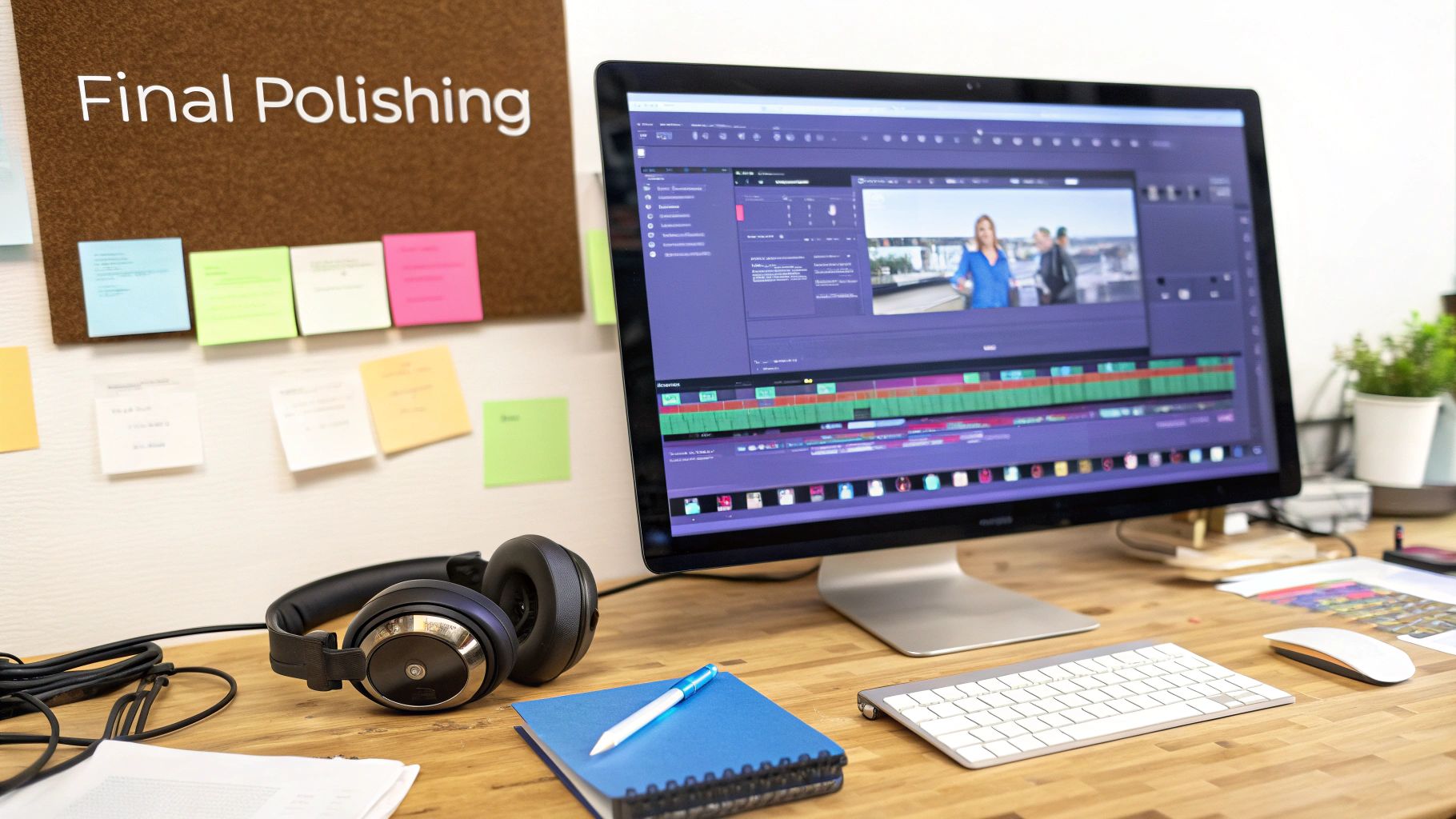
You've got a folder full of AI-generated clips, but the real magic is just getting started. A video is rarely ready to go straight out of the generator. The final assembly is where your raw assets get turned into an actual story—it’s the last 10% of the work that creates 90% of the final impact.
This is where you fix the pacing, smooth out the narrative, and add all the little details that make a video feel professional. Whether you're a die-hard Adobe Premiere Pro user or you prefer an editor with built-in AI assists, the goal is the same: take your best clips and build something cohesive.
This space is absolutely exploding. The market for AI-powered content tools, video included, was around USD 2.15 billion in 2024 and is expected to rocket past USD 10.5 billion by 2033. That growth tells you just how important these final editing steps are. It’s all about turning AI's output into something people genuinely want to watch. For a deeper dive, check out this AI content creation market report.
Stitching Your Narrative Together
First things first, let's build the basic story. Pull all your best takes into your video editor and start laying them out on the timeline, following your storyboard as a guide. You’ll see right away what’s working and what isn’t.
Is a scene dragging on too long? Cut it down. Does the jump between two shots feel awkward? Try a different clip or find a clever transition to make it feel seamless. Don't get too attached to any single clip—even if it looks incredible on its own, if it doesn't serve the story, it has to go.
Many editors today are built to make this process faster. If you want to see how modern tools can help, our guide on automatic video editing breaks down features that can seriously speed up your workflow.
Adding Layers of Polish
Once the basic sequence is locked in, it’s time to add the polish. This is what separates a simple string of clips from a finished piece that feels immersive and professional.
Here's what I always focus on at this stage:
- Color Correction and Grading: AI-generated clips often have slight differences in color or lighting. Use your editor’s color tools to make sure everything looks consistent. A solid color grade is one of the fastest ways to make your video look high-end.
- Sound Design: Audio is half the experience, period. Find a background music track that fits the mood and sprinkle in sound effects to give key moments more weight.
- Voiceover and Narration: If your video has a narrator, now’s the time to record the audio and sync it up with the visuals. You want the voiceover to complement what’s happening on screen, not compete with it.
- Text and Graphics: Use text overlays to highlight key messages, add a call-to-action, or just provide context. Simple animated graphics can also be a huge help for breaking down complex ideas.
This final stage is non-negotiable for creating high-quality AI video. It's the human touch in editing that refines the AI's output, fixes its imperfections, and ultimately brings your creative vision to life.
By taking the time to carefully assemble and polish what the AI gave you, you’re making sure the end result isn’t just a cool tech demo, but a genuinely effective piece of content.
Your Top AI Video Creation Questions Answered
Alright, let's get into the nitty-gritty. As you start diving into making videos with AI, you're bound to run into some practical questions. This space is changing so fast, so knowing what the tech can actually do (and what it can't) is everything.
I get asked about these things all the time, so let’s clear them up.
What Are the Biggest Hurdles at the Moment?
AI video tools are incredible, but they definitely have their quirks. The biggest headache for most creators is maintaining consistency. You can get a character looking perfect in one shot, but in the next, their shirt might be a different color or their face subtly changes. It can really pull a viewer out of the experience.
Another classic giveaway is weirdness with human hands and complex motion. You’ll see some bizarre physics or limbs that don't quite move right. It's getting better, but it's not perfect. Also, keep in mind that most generators produce clips that are only a few seconds long. That means building a full story is a process of stitching together a bunch of short outputs.
Can I Actually Use These Videos for My Business?
Yes, for the most part. Most of the big players give you full commercial rights to whatever you create on their platform. This means you’re free to use your videos in social media ads, on your website, or in marketing campaigns.
But here’s the critical part: you have to read the terms of service. This isn't just lawyer-speak. Some tools, especially the free ones, might slap on restrictions or require you to credit them. Always double-check the license before you build a campaign around a video.
What's This Going to Cost Me?
The price range for AI video is all over the map, which is great because there's an option for almost any budget.
Here’s a rough breakdown of what you can expect to find:
- Free Tiers: Perfect for just playing around. Most tools have a free version, but you'll likely have to deal with watermarks, lower quality output, and you probably won't get commercial rights.
- Monthly Subscriptions: This is where most serious creators land. Plans typically run anywhere from $20 to over $100 a month. What you pay usually depends on how many videos you can make, the resolution (like HD vs. 4K), and whether you get access to all the bells and whistles.
- Enterprise Options: If you're running a big team and need a ton of video, most companies offer custom plans with dedicated support and pricing.
The bottom line is that even a top-tier subscription is a fraction of the cost of a traditional video shoot, which can easily run into the thousands. That massive cost difference is exactly why so many people are jumping on board.
Ready to stop juggling multiple AI tools and start creating high-impact videos effortlessly? Sprello provides an all-in-one suite to generate scripts, storyboards, voiceovers, and stunning visuals in minutes. Streamline your entire workflow and ship more content that converts. Start creating with Sprello today!
